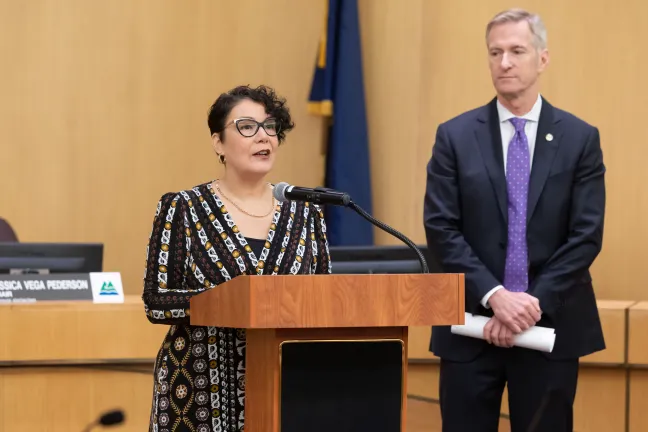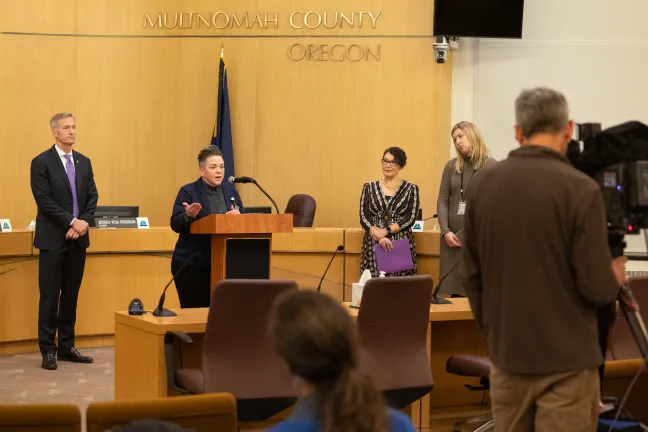Mayor Ted Wheeler and Multnomah County Chair Jessica Vega Pederson on Wednesday, Dec. 6, announced a shared framework for extending Portland and Multnomah County’s partnership in the Joint Office of Homeless Services for another three years, through June 2027.
Appearing together at a press conference, the Chair and Mayor laid out a series of strategic recommendations for their colleagues on the full City Council and County Board of Commissioners to consider as part of formally approving a new intergovernmental agreement once the current contract expires next summer.
The recommendations list newly detailed goals and metrics, robust commitments around budgeting, data sharing and financial reporting, as well as a plan for a new community governance structure to guide both the City and County in their shared work.
The governance structure would, for the first time, bring together all County and City department directors whose work affects behavioral health, housing, poverty, homelessness and criminal justice, and join them with other regional and state peers.
Among the recommendations for the Joint Office, shared by the Mayor and Chair:
- Identifying a baseline number of people experiencing unsheltered homelessness as of January 2024, and working to rehouse or shelter a number of people equivalent to 50% of that baseline number by Dec. 31, 2025 — understanding that even as people move into shelter and housing, additional people will become homeless in that same span
- Achieving a 15% increase in people who leave shelter for housing by Dec. 31, 2025
- Ensuring at least 75% of people rehoused into permanent supportive housing retain their housing 24 months after placement
- Confirming that the City and County should continue approving their own portions of the Joint Office budget, but requiring more cross-jurisdictional staff collaboration in the development of the overall budget
- Requiring at least quarterly reports for the City and County on the goals in the agreement, and a public budget dashboard that shows budgeting and spending by program and revenue source for each fiscal year.
- Creating a “Homelessness Response System” governance model to jointly create goals, craft strategies and engage with the larger system of care
- Service expansion, including new projects and programs, will be led by the Joint Office; existing service programming shall be transferred under the Joint Office on the condition of continued progress toward outcomes
Comments from elected leaders and local partners
“These new approaches to how we work together will change lives, our streets and our community. The framework we unveil today will dramatically enhance the partnership and coordination of our homelessness response across departments, bureaus and providers and get us truly aligned in dealing with the crisis on our streets,” said Chair Vega Pederson.
“Clear accountability and transparency must be at the forefront as we urgently work together to address Portland's homeless crisis,” said Mayor Wheeler. ”Today's revised agreement marks a new beginning and resets the table for how the City of Portland and Multnomah County work together to address homelessness, by establishing clear goals, with measurable and achievable outcomes.”
“I applaud the Mayor and the Chair for developing a framework that is essential to addressing the current crisis, and I look forward to partnering with them on its success. This type of partnership and inter-governmental work is precisely what this moment calls for,” said Governor Tina Kotek.
“We enthusiastically support the increased collaboration reflected in the proposed Intergovernmental Agreement,” said Mindy Stadtlander, CEO of Health Share of Oregon. “Our houselessness crisis demands an all-hands-on-deck approach, and that begins with cooperation at the local level. I particularly appreciate the evidence-based, data-driven recommendations and measurable goals outlined in the agreement; we’ll need this precision and accountability to address the multiple co-occurring crises contributing to houselessness in our region. We’re grateful for the cross-sector leadership of the Mayor and Chair and look forward to partnering with the City and County at every step to support the most vulnerable members of our community.”
Details on the goals and governance structure
Beyond the shared goals around unsheltered homelessness overall, the recommendations proposed by the Mayor and Chair also call for higher rates of reductions among specific priority groups of people:
- Black/African American, or African
- Native Hawaiian or Other Pacific Islander
- American Indian, Alaskan Native, or Indigenous
- Latina/Latino/Latinx
- Asian, Asian American
- Adults over the age of 62
All metrics and outcomes related to unsheltered homelessness would be part of a coordinated shelter strategy — work that’s already under way, after it was recommended in October in a third-party review of the Joint Office.
According to the framework, metrics and outcomes will be informed by the latest data from the Homeless Management Information System services database, including Built for Zero data, existing by-name lists, and all quality data sources.
The Joint Office will provide an update on the shelter strategy during a joint session of the City Council and Board of Commissioners on Thursday, Dec. 6, a followup to a meeting in September that was the first in-person joint briefing since 2019. County Commissioners Julia Brim-Edwards and Lori Stegmann are serving on a shelter strategy steering committee with City Commissioners Carmen Rubio and Dan Ryan.
The proposed new governance structure — called the “Homelessness Response System” — would consist of three committees: a Steering and Oversight Committee, an Implementation Committee, and a Community Advisory Committee.
Voting members on the Steering and Oversight Committee would include the Multnomah County Chair, the Portland Mayor, a designated County Commissioner, a designated City Commissioner, and a designated elected leader from an East County city.
The oversight committee, which would meet every other month, would set strategies and key performance indicators; monitor progress and performance toward goals; ensure alignment of jurisdictional investments toward strategies and performance; adjust annual goals at the completion of each year and assess strategies based on performance; and review audits of the various components of the Homelessness Response System.
The voting members would be joined by a handful of non-voting members engaged in homelessness, health and housing policy work.
The oversight committee would receive support from an Implementation Committee and a Community Advisory Committee.
The Implementation Committee would meet monthly and include a range of County and City department directors, the Portland City Manager (or Interim City Administrator) and County Chief Operating Officer, and regional and state policy stakeholders.
It would drive and direct the implementation of goals, strategies, and outcomes approved by the Steering and Oversight Committee; draft investment plans for the Steering and Oversight Committee; operationalize the strategies and key performance indicators; monitor progress toward goals and practice continuous quality improvement; and oversee and manage data dashboards.
The system’s Community Advisory Committee would include people with lived experience with homelessness, as well as representatives from the business community, labor organizations, service providers, housing providers, first responders, and others. The committee would also serve as the County’s Community Budget Advisory Committee for the Joint Office.
The Homelessness Response System would significantly expand and refine elements that had been part of the previous “A Home for Everyone” community governance structure, which was focused solely on the Joint Office and was replaced in 2022 with a cadre of community advisory bodies.


